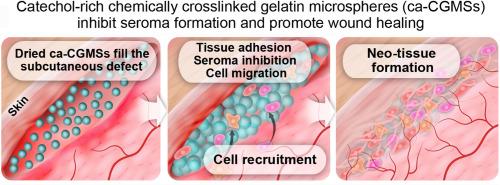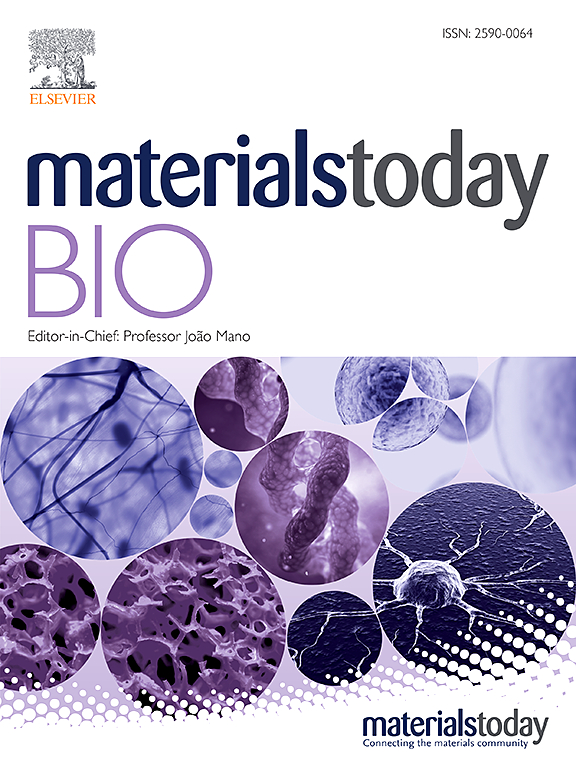Catechol-rich gelatin microspheres as restorative medical implants intended for inhibiting seroma formation and promoting wound healing
IF 8.7
1区 医学
Q1 ENGINEERING, BIOMEDICAL
引用次数: 0
Abstract
Seroma formation and poor wound healing are common complications of many surgeries that create anatomical dead space (i.e., mastectomy), often causing tissue infection and even necrosis. Although negative pressure drainage and tissue adhesives are investigated to alleviate fluid accumulation post-surgery, however, their therapeutic efficacy remains unsatisfactory in most cases. Herein, the catechol-rich chemically crosslinked gelatin microspheres (ca-CGMSs) have been developed as biodegradable reconstructive implants for preventing seroma formation and concurrently promoting subcutaneous wound healing. Compared with the most representative hydrogel adhesive, i.e. commercial porcine fibrin sealant (PFS), the loosely packed ca-CGMSs with diameters range from 50 to 350 μm, provide numerous cell-adhesive interfaces and interconnected macro-pores for enhanced cell adhesion, proliferation and migration. Subcutaneous embedding trials show the in situ swelling aggregation and wet tissue adhesion of ca-CGMSs as well as their capacity in recruiting autologous cells in rat mastectomy models. The trials in rabbit mastectomy models demonstrate that, compared with PFS gluing, the implanted dried ca-CGMSs not only significantly inhibit seroma formation, but also achieve enhanced wound healing by inducing the formation of vascularized neo-tissue. The ca-CGMSs show a great potential to be the next-generation of restorative materials for both preventing seroma formation and healing subcutaneous wounds.

富含儿茶酚的明胶微球作为修复性医疗植入物,用于抑制血清肿形成和促进伤口愈合
血清肿形成和伤口愈合不良是许多造成解剖死腔的手术(如乳房切除术)的常见并发症,通常会导致组织感染甚至坏死。虽然研究人员通过负压引流和组织粘合剂来缓解术后积液,但在大多数情况下,其疗效仍不理想。在此,我们开发了富含儿茶酚的化学交联明胶微球(ca-CGMSs),作为可生物降解的重建植入物,用于防止血清肿形成,同时促进皮下伤口愈合。与最具代表性的水凝胶粘合剂(即商用猪纤维蛋白密封剂(PFS))相比,直径在 50 到 350 μm 之间的松散包装 ca-CGMSs 可提供大量细胞粘合界面和相互连接的大孔,从而增强细胞的粘附、增殖和迁移能力。皮下包埋试验表明,ca-CGMSs 具有原位肿胀聚集和湿组织粘附性,并能在大鼠乳房切除术模型中招募自体细胞。在兔子乳房切除模型中的试验表明,与 PFS 粘合相比,植入的干燥 ca-CGMS 不仅能显著抑制血清肿形成,还能通过诱导血管新生组织的形成促进伤口愈合。ca-CGMS显示出成为新一代修复材料的巨大潜力,既能防止血清肿形成,又能促进皮下伤口愈合。
本文章由计算机程序翻译,如有差异,请以英文原文为准。
求助全文
约1分钟内获得全文
求助全文
来源期刊

Materials Today Bio
Multiple-
CiteScore
8.30
自引率
4.90%
发文量
303
审稿时长
30 days
期刊介绍:
Materials Today Bio is a multidisciplinary journal that specializes in the intersection between biology and materials science, chemistry, physics, engineering, and medicine. It covers various aspects such as the design and assembly of new structures, their interaction with biological systems, functionalization, bioimaging, therapies, and diagnostics in healthcare. The journal aims to showcase the most significant advancements and discoveries in this field. As part of the Materials Today family, Materials Today Bio provides rigorous peer review, quick decision-making, and high visibility for authors. It is indexed in Scopus, PubMed Central, Emerging Sources, Citation Index (ESCI), and Directory of Open Access Journals (DOAJ).
文献相关原料
公司名称
产品信息
阿拉丁
sodium nitrite
阿拉丁
dopamine hydrochloride
阿拉丁
ethyl-dimethyl-aminopropylcarbodiimide (EDC)
 求助内容:
求助内容: 应助结果提醒方式:
应助结果提醒方式:


